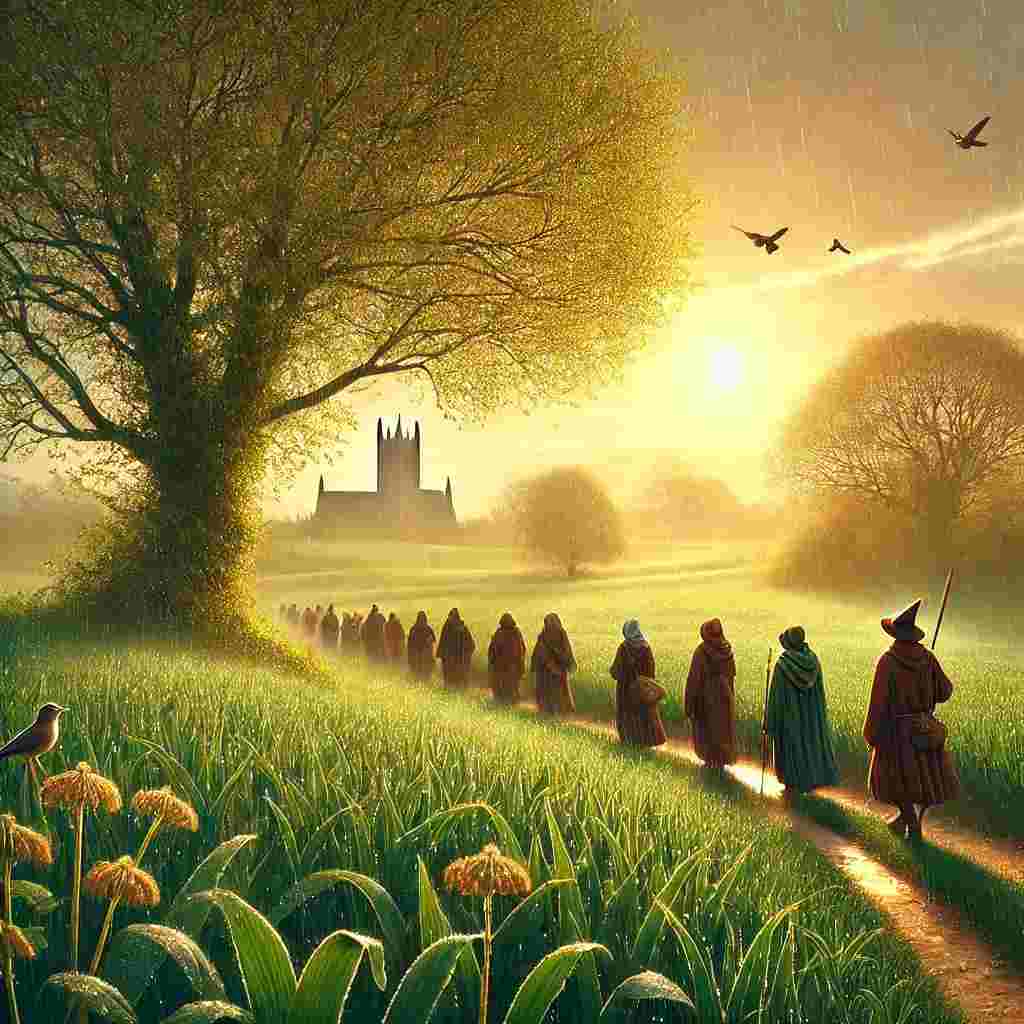General Prologue - Opening (Middle English)
Geoffrey Chaucer
c.1343 to 1400

Want to track your favorites? Reopen or create a unique username. No personal details are required!
Whan that Aprille with his shoures soote
The droghte of March hath perced to the roote,
And bathed every veyne in swich licour
Of which vertu engendred is the flour;
Whan Zephirus eek with his sweete breeth
Inspired hath in every holt and heeth
The tendre croppes, and the yonge sonne
Hath in the Ram his half cours yronne,
And smale foweles maken melodye,
That slepen al the nyght with open ye
(So priketh hem Nature in hir corages);
Thanne longen folk to goon on pilgrimages,
And palmeres for to seken straunge strondes,
To ferne halwes, kowthe in sondry londes;
And specially from every shires ende
Of Engelond to Caunterbury they wende,
The hooly blisful martir for to seke,
That hem hath holpen whan that they were seeke.
Geoffrey Chaucer's General Prologue - Opening
Geoffrey Chaucer’s General Prologue to The Canterbury Tales is a cornerstone of English literature, widely recognized as an exemplary introduction to a medieval narrative masterpiece. This opening passage establishes the framework for the tales: a pilgrimage to the shrine of Saint Thomas Becket in Canterbury. In these opening lines, Chaucer employs vivid natural imagery, rhythmic language, and a reverent tone to connect the vitality of spring with the spiritual renewal sought by the pilgrims. These lines exemplify Chaucer’s dexterity with Middle English verse, his keen observational skills, and his deep engagement with the culture and worldview of his time.
Analysis of Key Elements
1. The Invocation of Spring
The poem opens with a sensory-rich description of April’s rejuvenating showers:
Whan that Aprille with his shoures soote
The droghte of March hath perced to the roote...
Here, Chaucer invokes the cyclical renewal of nature, emphasizing the rejuvenation of life through spring rains that penetrate the dryness of March and nourish the roots. The juxtaposition of "shoures soote" (sweet showers) with "droghte" (drought) captures the transformation from dormancy to fertility, symbolizing both physical and spiritual renewal. This parallel is central to the General Prologue, as the pilgrims embark on their journey not just for physical travel but for spiritual rejuvenation.
2. Personification of Nature
Chaucer anthropomorphizes natural forces such as Zephyrus, the west wind:
Whan Zephirus eek with his sweete breeth
Inspired hath in every holt and heeth...
Zephyrus breathes life into the “tendre croppes” (tender shoots), highlighting the nurturing forces of nature. The depiction of the young sun (“yonge sonne”) traveling through Aries reflects medieval cosmology, linking celestial cycles with earthly phenomena. This connection between the macrocosm (the heavens) and microcosm (human lives) underscores the harmony between divine creation and human action.
3. The Awakening of Life
Chaucer extends his focus to birds:
And smale foweles maken melodye,
That slepen al the nyght with open ye...
The "smale foweles" (small birds) symbolize the joy and vitality of spring, awakened by Nature’s prodding ("So priketh hem Nature in hir corages"). This scene emphasizes the profound impact of natural cycles on all living creatures, suggesting an innate, universal drive toward renewal and purpose.
4. Pilgrimage as a Social and Spiritual Act
The transition from the natural world to human activity is seamless:
Thanne longen folk to goon on pilgrimages...
The longing for pilgrimage arises as a natural counterpart to spring’s renewal. Chaucer presents the act of pilgrimage as both a spiritual necessity and a social phenomenon. The repetition of "to seken" (to seek) emphasizes a collective, almost instinctual yearning for divine connection. The specific destination, Canterbury, with its “hooly blisful martir,” connects the natural and spiritual themes, as Saint Thomas Becket is revered for healing and intercession.
5. Universal Appeal
Chaucer situates his narrative within a broad societal context:
And specially from every shires ende
Of Engelond to Caunterbury they wende...
This framing of pilgrimage as a unifying activity across England illustrates the diversity of people who undertake such journeys. By encompassing all "shires," Chaucer sets the stage for the richly varied cast of characters in the tales, reflecting a microcosm of medieval English society.
Form and Structure
Chaucer employs the rhyming couplet of iambic pentameter, which later evolved into the heroic couplet. This rhythmic, melodic verse mirrors the energy of spring and the purposeful movement of the pilgrims. The enjambment between lines creates a flowing, organic quality, reflecting the natural and spiritual journey at hand.
Conclusion
The opening lines of Chaucer’s General Prologue establish a masterful interplay between nature, spirituality, and human endeavor. Through vivid imagery, personification, and rhythmic verse, Chaucer encapsulates the essence of spring and its connection to the human spirit's longing for renewal. These lines set the tone for The Canterbury Tales as both a celebration of life’s diversity and a meditation on shared human experiences.
This text was generated by AI and is for reference only. Learn more

